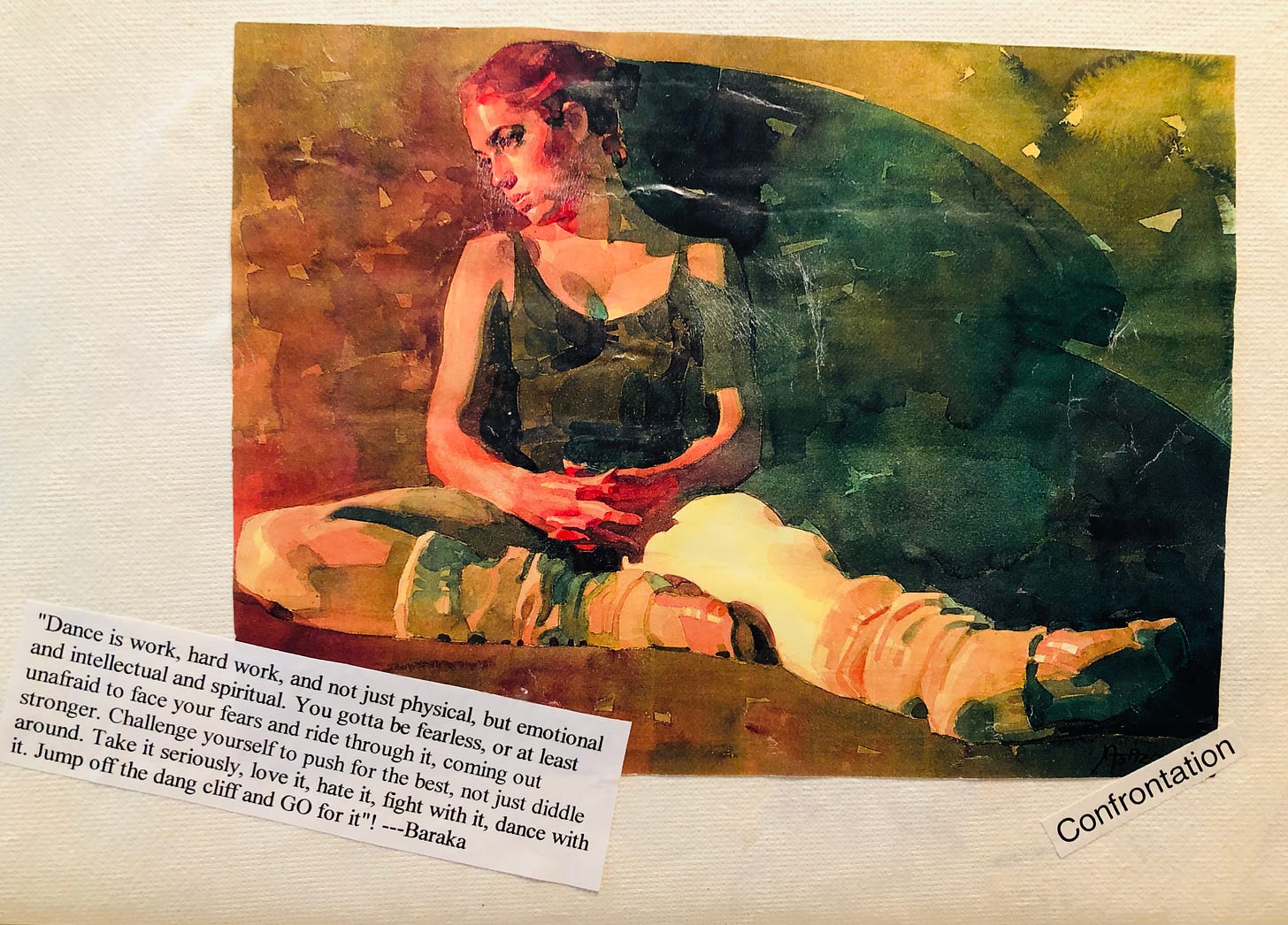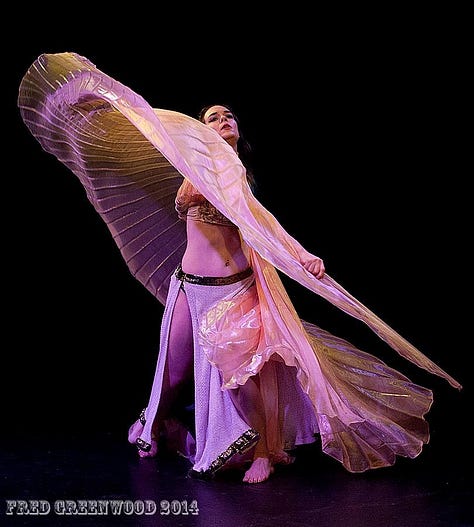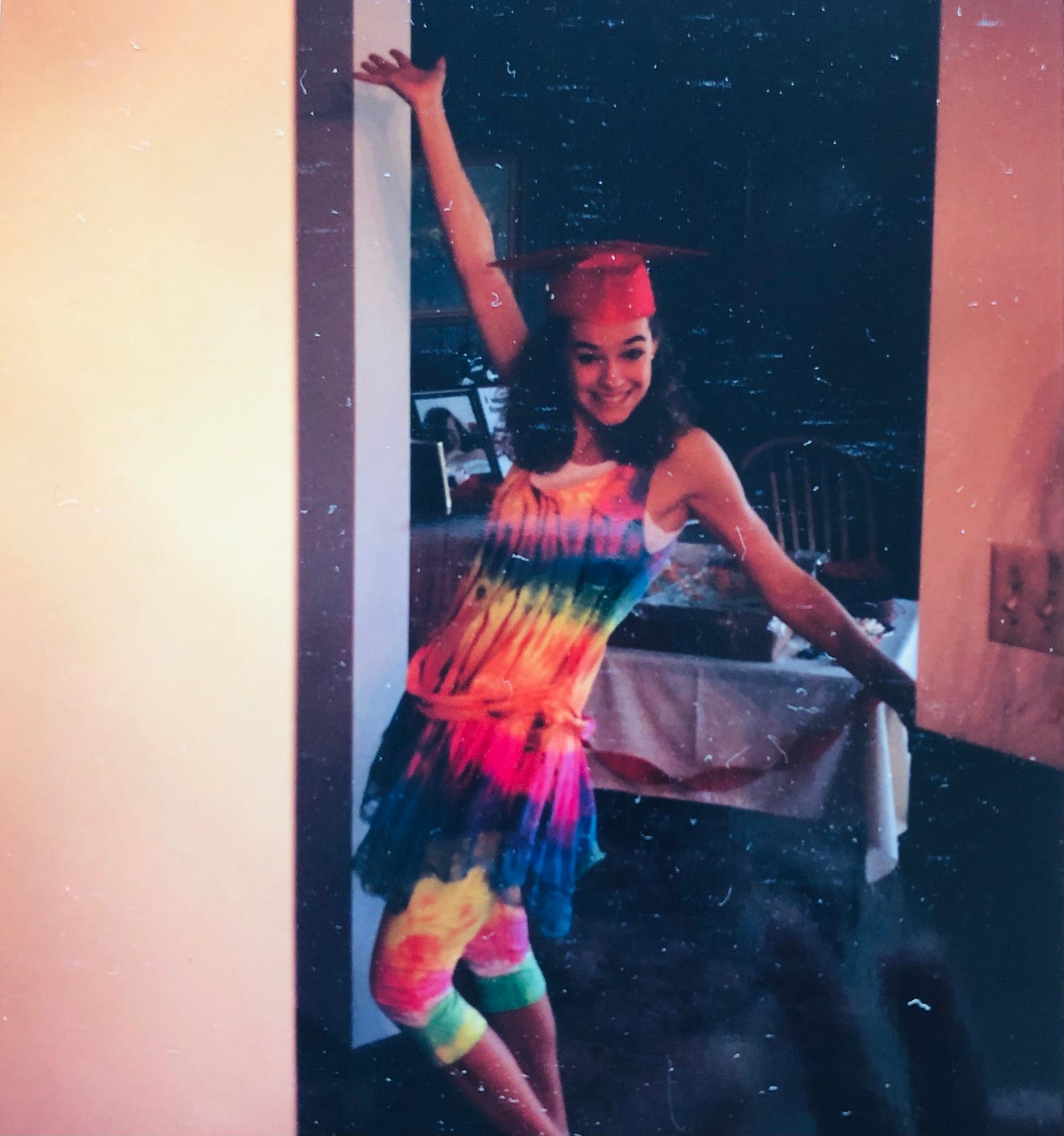Ugly Ducklings, Swans & Birds of Different Feathers
BellaDancer takes Ballet--finds Loie Fuller, Isis Wings & Skirt Dancing instead

Fall 1991
18 years old
I used to think I was good at dance. Now, training among real dancers for the first time in my life — dancers who have been taught by other real dancers since they were in elementary school or younger — I feel like a one-legged ox on a tightrope. The gazelles leap and prance around me. The swans flit and float.
And then there’s me.
In the studio mirror — more so in the eyes of the swans and our professor — I catch the reflection of myself when I try to pas de bourrée. I’m worse at jeté, and an absolutely nightmare trying to make it grand. On me, it’s more…bland.
Lurch-hoist! Whump.
Slump.
Can it be over now? I used to live for every moment I was able to dance. When I signed up for the first semester of my Theater Major and Dance Minor, I was elated to see Ballet I & II on my list of required courses.
Now I just want this hour of torture to pass.
My teacher surveys us from her spot in the corner near the tape deck. She points a critical finger at me, accompanied by the stern-eye. “Dance with your body, not your face.”
I cringe and try to paint the serene expression across my too-expressive features. I know, I know. I’m all eyes and eyebrows and oversized grin. But the music was so gorgeous just then, and I really love this combo and I wish I could do it a shred of justice but—
Breeeeathe…
Sereeeeeene…
Flutter. And fwip. And fwip. And float. And turn. And flutter and flyyyyy—
Whump.
I trudge back to my spot in line behind the more experienced girls. Two of them flick a glance at me, share an eye-roll, and turn their backs on me.
I do not fit in here at all. I know that, but this class is required for both my minor and major. A year of Ballet is the prerequisite for the entire dance curriculum. I get why. I’m sure when it’s all over I’ll be glad. But can’t we fast-forward to that day?
I force my heaving sigh to trickle from my lips in silence. My loathing of this class has little to do with being new to it. All my life, I’ve been challenging myself to learn new moves I can’t pull off at first but that I really, really want to. I actually love the taste of that kind of challenge. I live to sink my teeth into it, and this adventure is no different. Certain things are improving with every week. Strength, flexibility, posture, breathing. Everything my dancing so desperately needs.
But other things…
At least I’m paired with Terri. She is a jazz and tap dancer. “Oh, my gawwwd,” she mutters across my shoulder with her teeth clenched so the professor can’t read her lips. “I’ve been dancing for eight years, but I feel like a damn elephant out there.”
It’s horrible how good it feels to hear her say that. I thrust out my hand in greeting. “Hi. I’m Alexx Cloddy-Shod Oxx . Nice to meet you.”
We share a good chortle, then scoot farther down the line toward the corner-of-doom where we’ll have to do the whole combination again, starting on the left hoof. That’ll be even worse, I guarantee.
This is good for me. This is good for me! I know this. It’s what I’ve needed my whole life, but I also know something more.
I hate Ballet.
Actually, that’s not accurate. I hate doing Ballet. I’m so glad to be learning all this foundational technique, and I love to watch the swans. I could watch them all day. But dancing like this myself? It’s just…not me. Not in body, not in spirit. I’d been waiting and waiting to graduate from my hometown of Hell so I could finally grow my ugly duckling self up into the swan I just knew was in here somewhere. Now that I’m swimming with real swans, I see the truth.
I’m not one of them either.
Unfortunately, I have yet to discover birds of my feather.



“WHAT IF?”
Through the alchemy of those two words,
something new comes into the world.
~David Morrell
THE SKIRT DANCERS
As the 19th Century closed, many dance rebellions took place in Europe and the United States against strict Ballet technique: Vaudeville and Burlesque, the Can-Can, the Skirt Dance, and its evolution: Loie Fuller’s famous Serpentine Dance. (Further geek-out links for these styles and their history can be found below.)
Ballet of the day:
A brief, silent snippet of Skirt Dancers, 1896:
Another snippet - Skirt Dance in toe shoes, superimposed upon Niagra falls footage, around 1900:
Here we’re transitioning from Skirt Dance into Serpentine, or what we would today call a variant of ginormous Isis Wings. Ameta in 1903:
As the description on this YouTube Video reads: ads in the New York Clipper proclaim “mirror dancer” Ameta “the most elaborate act in vaudeville.” They describe four dances performed by Ameta, none of which appears to be the dance featured in this film: a “shower of confetti, ribbons;” a “prismatic fountain of real water;” a fire dance…
LOIE FULLER - QUEEN OF THE SERPENTINE
The last of my dancey great-great-grandmothers that I’ll be covering today is Loie Fuller (1862-1928). She was originally a child actress who later performed and choreographed in circus shows, Vaudeville, and Burlesque as a skirt dancer. She had her own improvisational style and technique based on more natural movements than Ballet.
She is a contemporary of Isadora Duncan, whom Loie introduced to European audiences via their touring days together (and who had such a huge impact on me that she requires a post of her own).
Loie Fuller was one of the pioneers of the Free Dance movement in the USA. This style helped lay the groundwork for what would become Modern Dance.
But she was more than an actress and a dancer. She was also renowned as a patented inventor who experimented with the wonders of lighting to cast colors upon the silk of her costumes, and later, that for which she is most famous: wielding immense swaths of swirling silk—sometimes hundreds of yards!
She called it her Serpentine Dance.
It is from Loie and her contemporaries (and imposters) that I’ve inherited great scads of my own fabric wielding. Before I ever saw doube-veil, Isis wings, or the painted, stick-wielded silk butterfly and faerie wings so popular today, before there was Amazon to deliver such things to my doorstep—and way before I could afford to buy silk—I split my cotton circle skirts and swirled them through the air like veils. I also pinned big half-circles to the shoulders of my costumes and used them in a fashion reminiscent of Loie Fuller’s silk extravaganzas.
Was this a long-buried seed from my Modern Dance and Dance History studies in college? Were those old black-and-white clips we ogled on a small TV/VCR screen while camped out on the marly floor of the main dance studio embedded into my teeny-dancer brain? Did Loie Fuller whisper to me through the timeless aether of Terpsichore, Muse of Dance?
Who knows?
Here she is using another technological wonder of the day: movie magic—oooooh… (Although it’s said that not all the footage is actually her, as she experienced legal issues with imposters. Others say there is no footage of her dancing at all.)
This is the 2011 re-staging of Loie’s 1925 dance La Mer:
THE IMPACT ON BELLY DANCE
In addition to influencing the earliest dancers who would eventually pioneer Modern Dance — the style I dove into much more deeply after bungling Ballet — these early rebellious forms also impacted what would become the so-called “Westernized” nightclub or cabaret styles of belly dance.
(I hear this style is now being called “Vintage Orientale.” Let me now if it changes yet again. It’s been called so many different things by so many different people over the past decades, and I’ve been out of the scene for many years.)
These glitzy belly dance styles, in return, circled back to influence any Middle Eastern styles that catered to the “exotic mystique” of Western Orientalism and the glam of Hollywoodization…which then convinced some Western dancers that they’d learned and passed down “authentic, ancient, sacred and traditional” styles, only to learn later how Westernized, commercialized, and modern they really were…
It’s a can of worms that we’ll crack open bit by bit, because it sure messed with my head while I was trying to sort it out on too many myths and not enough access to dance history during my analog and dialup internet days of the 1990s and early 2000s.
THOSE DASTARDLY AMERICANS
In certain corners of the belly-world, Westernized dance and its descendants became known, and also criticized, for flinging our huge skirts around. Some of the growling is personal preference; some is cultural. For example, in certain Romany cultures, it’s taboo to touch one’s skirt, much less make an entire dance doing so.
We also shock and appall some people by peeling veils off our bodies in the manner of a strip-tease, only to swirl them around like a matador and litter the floor with them, rather than wearing them as sacred and/or traditional garments. Others say that the veil should only be used for briefly flitting and flying as an elevation of the carriage to create a graceful line upon entry, then discarded to get down to the “real dancing,” rather than all these cloth-acrobatics stealing the show.
There are a lot of heated opinions about these things.
Me? For once the Fire Sign doesn’t have much heat over this matter, except around the fact that art and creativity are fluid. Dance is always in motion. (Har har. I know, I can’t help myself.)
As long as we’re not saying that we’re doing a traditional somethin’-somethin’ from somewhere-somewhen when we’re not, I have never understood the problem with innovation, experimentation, or combination. That is another rabid-rabbit hole unto itself, with even more heated opinions on both sides.
Super fast-n-furious history/mythology lesson: the legendary birthplace of the North American continent’s main exposure to what was scandalously billed as the Hoochie Coochie or “danse du ventre” (French for “dance of the stomach”), was at the 1893 World’s Columbian Exposition (a.k.a. the Chicago World’s Fair), and through the various dancers known as “Little Egypt”. No historical record can be found of this dancer at the Expo, but later dancers went by this name to cash in on the fame.
Some say there was stripping involved; others say there wasn’t, but Westernized belly dance has been tied to that scene ever since.
Later, the Vaudeville, Burlesque, Circus, and Renaissance festival scenes gave birth to another breed of belly dance that started on the US West Coast as a rebellion against the spangly cabaret scene: the Tribal and Fusion Belly Dance styles.
Some dancers refused to choose a camp, presenting pieces from Camp Sparkle, Camp Earthy Fusion, and/or Camp Historic Folkloric in the same show. Still others refused to keep their sequins out of their folkloric, and their heavy-metal chunk jewelry off their flowing silks and satins. The mating of these disparate styles spawned…
Well, dastardly hack-bastardizers like me. ✨😈✨
My style is an absolute descendent of all these influences. If my maternal line is belly dance, then my paternal line is classical Western dance, particularly proto- and early-Modern, Jazz, and Tap—all rebellious departures from the longtime dominance of Ballet. While I was cutting my teeth, both of my bloodlines were working very hard to downplay, deny, or outright erase their Vaudeville and Burlesque inheritances, with all the slut-shaming joys that go with it.
Yet these early influences shine right through me like my almond-shaped eyes, my peachy-pale skin, and the cowlick at the back of my hair.
There is no denying whose child I am.
From dancing with fire to dancing in fountains. From swirling skirts to whirling wings. From superimposing myself on video to mix-matching styles in the creation of something new. From dressing in spangles and sparkles that leave little to the imagination to combining layer upon layer of ornate, imported textiles that leave only a smidge of visible skin.
As a descendent and devotee of so many rebellious artists, explorers and scientists, I am continually asking, “How else can I use *whichever groovy thing or concept I’m into today* in a way that I’ve never done or seen before?”
I do gushy moves or floor work amidst a drum solo. I use Isis wings as though they are martial Kali sticks, or as my "carpet" from which to roll out of as the mythical “Cleopatra” (in contrast to the historical figure — something else we’ll cover later).
And — you betcha! — I have been mistaken for a strip-tease artist more times than I can count, I’ve been propositioned over and over for a lot more than stripping, and I’ve been lambasted from all three camps (Folkloric, Cabaret and Tribal) for my refusal to stick with one style and “master” it.
I am the melting-pot, mutt lovechild of all these lineages, as can be seen in my first YouTube video ever, dancing in a fountain with matador veils and a coin belt to a song from a movie I had just fallen in love with, Mira Nair’s Monsoon Wedding.
Pueblo, CO 2006:
Tips of the hat to my Burly-Q, Vaudeville and Can-Can ancestors. My first time in Memphis, TN, 2009:
Proof that, occasionally, I really can-can-can be just a straight-up entertainer. With my dearest Deargan in a fusion dance we choreographed together for one of our sold-out shows at the Runyon Theater. Pueblo, CO 2008:
And of course, one of my own skirt dances.
This one weaves in large chunks and small hints from a number of my studies: Mexican Folklorico, Modern, Tap, Irish, Turkish Romany, the Turkish Oryantal-influenced styles of belly dance, and fusion styles like Tribal and Dalia Carella’s Dunyavi. (More on those later, if you have no clue what I’m talking about.) Oh. And yeah. A couple hints from my martial training. Hi-yah!
As you can see, I prefer putting together costuming or choreographic combinations from widely varying styles, and dancing to music that they don’t normally accompany, rather than trying to reenact long established traditions.
There are a gazillion people out there who are really good at upholding culture and tradition in their art forms. Their place is a sacred one.
But that’s not what I do.
Well, actually, that’s inaccurate. I DO uphold a very specific lineage and tradition: that of the Innovator. The Alchemist. The Explorer. The Inventor.
And that path is just as sacred.
The dance that encompasses my most obvious Loie Fuller inheritance. Movie magic, lighting, and multiple wings used unconventionally to tell the tale of the many times I have had my wings broken and re-learned how to fly. Memphis, TN 2019:
Up Next: IZZY & ISADORA - DUNCAN THAT IS - “Ohhh, your dance name is Isidora? Is that in honor of Isadora Duncan?” No. Annnnd a resounding… sorta? But I always appreciate that you think of me that way.
You are hanging out in the DanceStory Section here on Tinkerings: Dance, Story, History - mine and that of the dancers, artists, entertainers, & characters who made me.
SOURCES & MORE INFORMATION
To get you started and help you determine if you want to go further down this rabbit hole - The Wikis:
More about the myth of “Little Egypt”
One of Thomas Edison’s clips from 1896 that was hailed as “a clip of Little Egypt” the first times I ever saw it. This video was considered so scandalous in its day that they censored her chest and hips for part of it. On the YouTube description there’s a bunch of its origins, even more in the comment discussion.
Hoochie Coochie - The Lure of the Forbidden Belly Dance in the USA
The book Looking For Little Egypt by Donna Carlton
A lovely article about Turkish Oryantal and Turkish Romany dance, with a handy list of links to some of my favorite practitioners.
Another article on skirt dancing by one of the foremost dance historians of those styles, Elizabeth Artemis Mourat
Veils in belly dance, including another detailed quote from Artemis
The Salimpour legacy — a primary bloodline of American cabaret and the fusion belly dance styles with Renaissance Festival & circus roots originating on the US West Coast
Additional places you can have a field day about belly dance, its history, and the art forms it comes from:
Dalia Carella, one of my favorite fusion artists who deeply inspired me — read: gave me artistic “permission” to be my dancer-self — while I was putting on my Mexican Folklorico practice skirts and doing…other things with them.
If you want a jump-start on some of our future adventures, here is an article that would have been highly useful in my baby belly dancer days but that, alas, I only discovered when I originally wrote this piece for my old blog a few years ago:
Kali Sticks - Filipino Martial Arts
That time the belly dancers had it out so vociferously on the internet that even the non-belly-world chimed in.
And while we’re at it, that long, involved conversation about calling it “American”. It just doesn’t flow. UnitedStatesian? Statesish? USian? Ugh. It’s a pain in the writerly flow of my lingual butt, just like the so-called “East-West” cultural dichotomy, so I hack away at it and tweak. Especially when conversing with dancers who have been using these terms for decades longer than I have been. Which…you know, hails back to 1992. Blah.







There is something special about sticking to something your drawn to, until you find the precise part of it that fits who you are.
It’s awesome you found your thing and it’s awesome you knew enough about yourself to know ‘your thing’ wasn’t ballet.
Ohhh and as always, a wonderful read. :)
The quote: dont' danse with you face , danse with your body made me laugh ... Please never tell your face not to express yourself ahahaha ! Happy you never did listen to that ! And yess candy ... Lot's of it I have seen, of course ;) The Fountain one made a huge impact on me back in da days. Caspian, that skirt dance arggg, did practice it ( the hand flick )....but it nerver looked that good on me ...little arms lol!! And with my 5ft ...Was not the same ahahah! But I did bring it , back home ,our little training session about those skirt moves . Seem so far now...